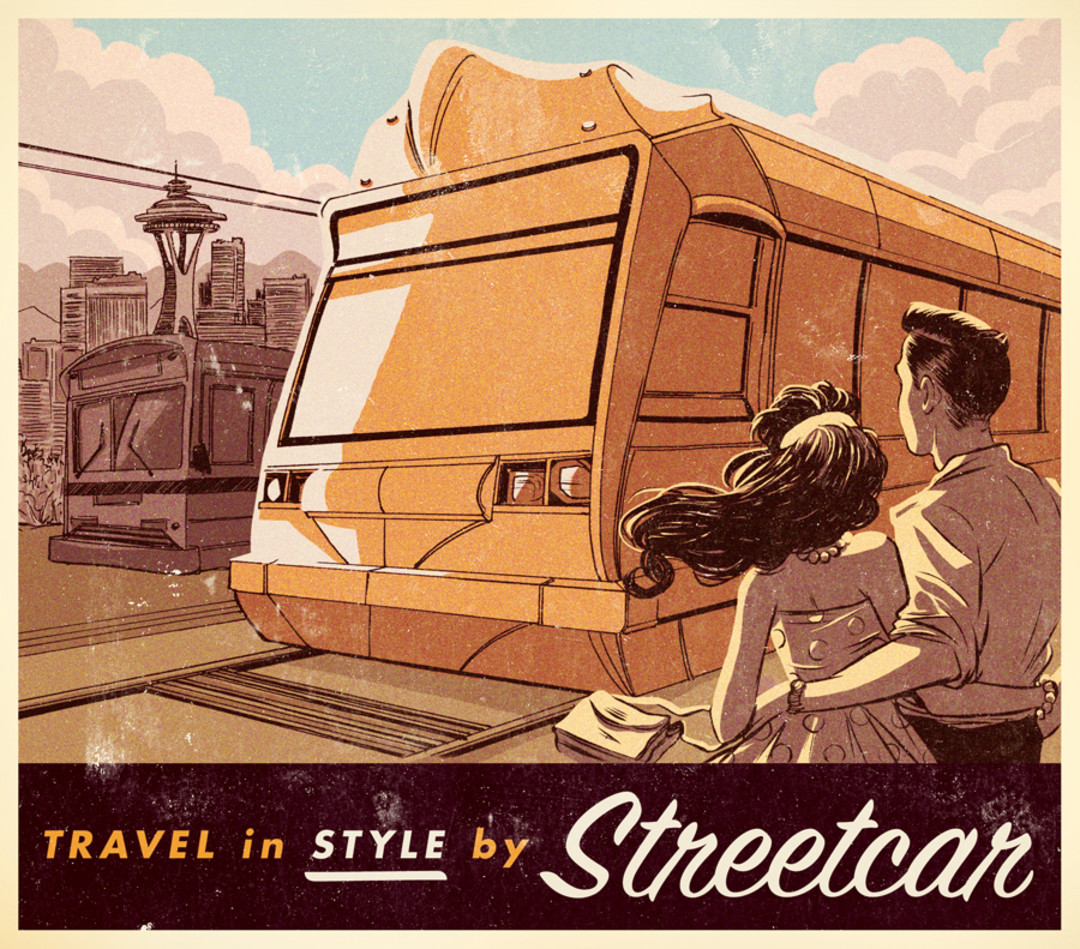Streetcars Paved with Gold

Image: Thomas Pitilli
JACK WHISNER learned the complexities of urban transit the hard way, designing bus routes at Metro Transit. Twenty years in those trenches hasn’t dimmed his passion for making transit work—or his dismay when it doesn’t. And so when he saw two other big transit players—Sound Transit and the City of Seattle—embarking on what seemed like a costly, counterproductive boondoggle, he didn’t just shrug his shoulders. Writing as a private citizen, Whisner sent a searing critique to Mayor Mike McGinn and the City Council (Read Whisner’s letter to Mayor McGinn and the City Council.)
The project in question is a second streetcar line, which Seattle plans to build across First Hill—between the light rail stations at Fifth and Jackson, and Broadway and John—with money from Sound Transit. Whisner wrote that it would be redundant in an area already heavily served by clean, quiet electric trolleybuses; if the city really wants to reduce carbon emissions, wouldn’t it make more sense to replace diesel buses somewhere else and upgrade the existing trolley service?
Furthermore, to avoid steep inclines and getting tangled in existing trolleybus power lines, the streetcar would have to detour for 10 blocks, up to 14th Avenue and back, adding to travel times and slowing traffic on busy arterials. Engineers would have to work the streetcar’s power lines around the trolleys’, which Whisner warned could cause construction delays, cost overruns, and more traffic disruption.
Rubber-wheeled trolleys climb steeper hills. They could run up Yesler to Broadway—a much more direct, less congested route, costing a small share of the $50 million per mile it takes to build a streetcar. That would leave funds to extend the line further down Broadway, something Capitol Hill folks are already clamoring for—perhaps even to the Ship Canal or U District—and keep the trolleys running “about every five minutes.”
“The First Hill streetcar is clearly a risky and suboptimal transit investment,” Whisner concluded. In a time of growing ridership, when cash-starved Metro must cut hundreds of thousands of hours of bus service, transit agencies should be seeking the most bang for their shrinking bucks.
Whisner isn’t alone in this view. At least three council members, including transportation chair Tom Rasmussen, are convinced. Nevertheless, two weeks after Whisner sent his critique, McGinn recommended the streetcar plan to the City Council, which subsequently approved it. The city plans to start construction later this year and finish by 2014. Even skeptics like Rasmussen concede the train has left the station and probably can’t be stopped.
The reasons have everything to do with two factors: the perceived ability of rail transit to attract development and new riders, and regional transit’s fragmented political landscape.
In recommending the streetcar route, McGinn noted it would spur the “revitalization of Broadway.” Economic development is the mantra of streetcar boosters around the country—including McGinn’s predecessor, Greg Nickels, who hatched both the First Hill project and the completed South Lake Union streetcar. The logic: Fixed, presumably permanent tracks reassure both developers and rookie riders, and sleek, Euro-style streetcars draw upscale passengers who disdain buses.
To the first argument, Tom Rasmussen likes to say, “Look up!” Trolleybuses also have fixed guideways, overhead. And new European trolleybuses have the same convenience and cool factor; San Francisco is buying them from the Czech company that made Tacoma’s and Portland’s streetcars.
Still, Rasmussen sees no hope of switching the Sound Transit funds over to trolleys. That money—$132 million—is compensation for a light rail station originally promised for First Hill, then nixed as too costly and risky. In 2008 voters approved a second Sound Transit package that included the streetcar; officials say they’re following the voters’ will. The Sound Transit board has however eliminated other voter-approved features, including an I-90 busway and light rail stations at Graham and South 200th streets. (Those would merely serve low-income passengers, not new development, and so were deemed expendable.)
Ethan Melone, the city’s rail program manager, says Sound Transit has told city officials it won’t fund “local” transit such as trolleys; a streetcar serving the same route qualifies as a “regional” solution. Whisner notes that other cities have negotiated with the regional agency for better terms: “Seattle can be just as assertive.”
Seattle has opted to go along, rather than risk losing the funds. But it’s not free money: It comes from Seattle taxpayers, and comes back to them at a price. The city must cover any overruns and, together with Metro, operating costs, as it does on Lake Union (where Vulcan paid most of the up front expense). The lightly used SLU streetcar costs the city about $500,000, plus 15,000 hours of lost bus service, per year. It cost $211 per hour to operate in 2009, versus $109 for Metro’s trolleys. Melone says that reflects “a higher level of maintenance and service” for rail, not an “intrinsic cost differential.” He avows costs will go down when “the system expands,” achieving “economies of scale.”
Now the city wants to double down on this bet with a second streetcar. It won’t be the last. After First Hill’s done, pressure will build for a downtown line that would connect it and the South Lake Union line. And help justify their existence.




